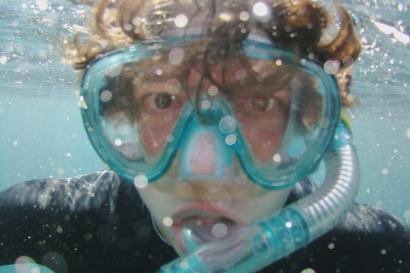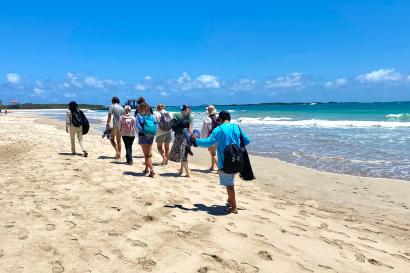Just three days after getting back from Tiputini we all met again at 4:30 in the morning to take a bus to Bellavista, a reserve in the high Andean cloud forests west of Quito. This trip was more reasonable than the last. We only traveled two hours, first on the highway then up a long dirt road up to an eco-lodge hanging off the side of a mountain.
There was one brief interruption when the driver spotted an Andean Cock of the Rock or as Brett, our professor, called it “HOLY (frenchtoast) AN ANDEANCOGADAROC!!” Unfortunately, although we all piled out of the van as fast as we sleepily could no one else was able to catch a glimpse of this incredibly rare “Weird Orange Chicken” as Brett described it.
Anyway, once we got to the lodge we walked through the gate to see what can only be described as a swarm of hummingbirds. I believe we counted at least three different species in our first five minutes there. We happened to see a squirrel as well which I didn’t pay much mind too, but later Brett mentioned that due to hunting and exploitation seeing any mammal, even a squirrel, in the High Andes is practically a miracle.
The building we stayed in was the coolest place I’ve laid eyes on. It’s a five-story bamboo dome that looks like it was built for a collective of wizards. The bottommost floor was inaccessible due to renovation, but we entered through the main level which is an open lounge area with hammocks and sofas. In the middle there’s a spiral staircase to the third floor which turns into a weird three-way ladder that’s used to access the final two stories. I had the top level, a circular room with panoramic windows and super low ceilings, all to myself. I had a private view of the sunrise from the top of our tower, and it was spectacular.
We spent most of the first day hiking the trails of the reserve. Personally, I prefer the climate in the cloud forest much more than that in the Amazon. Its cool, cloudy, misty, and the landscape reminds me of the forest covered hills back in Washington. The similarities end though with the presence of vines, tree ferns, bromeliad covered trees, and huge swaths of bamboo. The cloud forest was both familiar and alien; it felt much more exotic too me than the Amazon for which I had no frame of reference. There are many birds but for the most part the forest of Bellavista is quiet, when the clouds roll in everything will be dead quiet save for drops of water falling from the leaves or a the muffled call of a frog. The fact that I heard a frog at all was actually remarkable because amphibians in the cloud forest have suffered even greater rates of extinction than their counterparts in lowland rainforests.
During dinner that night one of the guides burst in asking to be excused for the interruption but an olingo was feeding in a tree outside the cafeteria. The Olingo is an animal not officially described by science until 2013. Its other name, kitty-bear, is the best description of its appearance I can give. Between the Olingo and the squirrel my expectations had already been exceeded but the next day we spotted a Tayra, a big weasel that looks a bit like a martin, as well that was feeding on the same bananas that had been left out for the Olingo.
After our two days at Bellavista we had a free weekend before our last fieldtrip on the mainland to the Páramo, the high Andean grassland. We all hopped on the bus, this time at a more reasonable 8:00, and drove up, and up, and up. After a transition from the highway to a dirt road our driver dropped us, our guide, and his seven-year-old daughter on the top of some snow-covered ridge at about 13,000 feet. Thus, began our three-hour hike through snow, slush, sleat, wind and rain. The landscape is gorgeous; by the end of the hike we had transitioned from high snowy tundra into marshy brown grassland past lakes, cairns, and gulley’s until finally we turned a corner and everything turned green as we found ourselves in a verdant valley of clouds. Conditions were admittedly awful especially because I didn’t have the right boots and my fingers were frozen stiff by the end. I acutallly really didn’t learn much about the ecology of paramo except to fear and respect it, but I’d go back as if I ever get the chance. We only had a short bus ride though until we were dropped off at Papallacta the resort town on the valley floor and the three hours we spent soaking in the hot springs after muddily shambling into the resort was a good balance to the first half of the day.

Xavaar Quaranto
<p>I grew up in Eatonville, a small town in Washington just outside the entrance to Mount Ranier National Park, but I moved to Seattle two years ago for college. There's a lot more to do in the city than back home; I've taken dance lessons, played clarinet in a campus band, and this summer I learned how to sail. Exposure to nature here is limited though. I used to go hike in the national park after work, but now I feel like I hardly leave the library! In the Galápagos I plan to spend plenty of time outside both on land and sea.</p>








